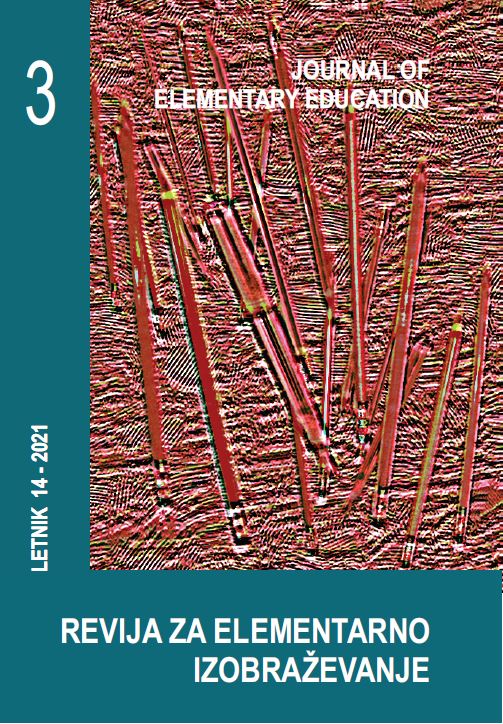The relation between intercultural Sensitivity and world music preferences Among grammar school and vocational School students
DOI:
https://doi.org/10.18690/rei.14.3.319-335.2021Keywords:
music pedagogy, intercultural sensitivity, musical preferences, world music, music educationAbstract
The paper explores the influence of the type of secondary education chosen by the participants on the level of intercultural sensitivity and world music preferences, as well as the connection between intercultural sensitivity and world music preferences. The research employed a general data questionnaire, the Intercultural Sensitivity Scale and an assessment scale to examine music fragment preferences in a sample of 124 participants. The results have significant implications for music and pedagogical theory and practice, in terms of increasing intercultural sensitivity and the tolerance of students towards members of other cultures and their music.
Downloads
References
Bedeković, V. (2015). Interkulturalna kompetentnost pedagoga u odgoju i obrazovanju za interkulturalne odnose. Virovitica: Visoka škola za menadžment u turizmu i informatici.
Carper, K. (2001). The Effects of Repeated Exposure and Instructional Activities on the Least Preferred of Four Culturally Diverse Musical Styles with Kindergarten and Pre-k Children. Bulletin of the Council for Research in Music Education, 151, pp. 41–50.
Chen, G. M. & Starosta, W. J. (1996). Intercultural Communication Competence: A Synthesis. In: Burleson, B. (Ed.), Communication Yearbook 19. Thousand Oaks: Sage, pp. 353383.
Chen, G. M. & Starosta, W. J. (2000). The Development and Validation of the Intercultural Communication Sensitivity Scale. Human Communication, 3, pp. 1–15.
Choate, R. A. (1967). Music in American Society: The MENC Tanglewood Symposium Project. Music Educators Journal. 53 (7), pp. 38–40.
Choi, J. (2010). Music Major Graduate Students’ Attitudes towards Multicultural Music and its Correlation with Multicultural Music Preference. Journal of Music Education Science, 10, pp. 81–94.
Curriculum of Music Education for Primary Schools and for Grammar Schools (2019). Zagreb: Narodne novine, No. 7.
Dobrota, S. (2009). Interkulturalno glazbeno obrazovanje. In: Djeca i mladež u svijetu umjetnosti / Ivon, H. (ed.). Split: Centar za interdisciplinarne studije - Studia Mediterranea; Filozofski fakultet Sveučilišta u Splitu; Hrvatski pedagoško-književni zbor, Ogranak Split, pp. 157–169.
Dobrota, S. (2012). Uvod u suvremenu glazbenu pedagogiju. Split: Filozofski fakultet Sveučilišta u Splitu.
Dobrota, S. & Reić Ercegovac, I. (2014). Students’ Musical Preferences: The Role of Music Education, Characteristics of Music and Personality Traits. Croatian Journal of Education, 16(2), pp. 363–384.
Dobrota, S. & Maslov, M. (2015). Glazbene preferencije učenika prema narodnoj glazbi. Metodički ogledi: časopis za filozofiju odgoja, 22(1), pp. 9–22.
Dobrota, S. (2016). Povezanost između interkulturalnih stavova studenata i preferencija glazbi svijeta. Život i škola: časopis za teoriju i praksu odgoja i obrazovanja, 62(1), pp. 209–218.
Dobrota, S. & Reić Ercegovac, I. (2016). Zašto volimo ono što slušamo: Glazbeno-pedagoški i psihologijski aspekti glazbenih preferencija. Split: Filozofski fakultet Sveučilišta u Splitu.
Dobrota, S. & Sabljić, M. (2018). Glazbene preferencije učenika prema klasičnoj glazbi u parnim i neparnim mjerama. In: Komunikacija i interakcija umjetnosti i pedagogjje / Radočaj-Jerković, A. (ed.). Osijek: Sveučilište Josipa Jurja Strossmayera u Osijeku, Umjetnička akademija u Osijeku, pp. 89–100.
Drandić, D. (2012). Interkulturalne kompetencije nastavnika i barijere u interkulturalnoj komunikaciji. In: Posavec, K. and Sablić, M. (eds.) Pedagogija i kultura – Interkulturalna pedagogija: prema novim razvojima znanosti u odgoju. Zagreb: Hrvatsko pedagogijsko društvo.
Feist, G. J. & Brady, T. R. (2004). Openness to Experience, Non-Conformity, and the Preference for Abstract Art. Empirical Studies of the Arts 22(1), pp. 77–89.
Fung, C. V. (1994). Undergraduate Non music Majors' World Music Preferences and Multicultural Attitudes. Journal of Research in Music Education, 42(1), pp. 45–57.
Getz, R. (1966). The Effects of Repetition on Listening Response. Journal of Research in Music Education, 14(3), pp. 178–192.
Hargreaves, D., Miell, D. & MacDonald, R. (2005). How do People Communicate Using Music? In: Miell, D.; MacDonald, R. & Hargreaves, D. (eds.), Musical Communication, Oxford: Oxford University Press, pp. 1–25.
Howard, K. (2018). The Emergence of Children’s Multicultural Sensitivity: An Elementary School Music Culture Project. Journal of Research in Music Education, 66(3), pp. 261–277.
Kim, M . & Yoon, M . ( 2016). R esearch on t he M ulticultural Music Education a t the College Level. International Journal of Humanities and Social Sciences, 5(9), pp. 290–299.
Kraus, E. (1966). Recommendations of the Seventh International Conference. International Music Educator. 14, pp. 452–453.
LeBlanc, A. (1981). Effects of Style, Tempo, and Performing Medium on Children’s Music Preference, Journal of Research in Music Education, 29(2), pp. 143–156.
Mesić, M. (2007) Pojam kulture u raspravama o interkulturalizmu. Zagreb: Odsjek za sociologiju, Filozofski fakultet.
Mirković Radoš, K. (2010). Psihologija muzike. Beograd: Zavod za udžbenike.
National Standards for Arts Education (1994). Consortium of National Arts Education Associations. Reston, VA: MENC.
North, A. C. & Hargreaves, D. J. (2008). The Social and Applied Psychology of Music, New York: Oxford University Press.
Palisca, C. (1964). Music in Our Schools: A Search for Improvement. Washington, D. C.: U.S. Government Printing Office.
Peery, J. C. & Peery, I. W. (1986). Effects of Exposure to Classical Music on the Musical Preferences of Preschool Children. Journal of Research in Music Education, 34, pp. 24–33.
Peko, A., Mlinarević, V. & Jindra, R. (2009). Interkulturalno obrazovanje učitelja – Što i kako poučavati?. In: A. Peko & V. Mlinarević (eds.), Izazovi obrazovanja u multikulturalnim sredinama. Osijek: Gradska tiskara Osijek.
Portalla T. & Chen G. (2010). The Development and Validation of the Intercultural Effectiveness Scale. Intercultural Communication Studies, 19(3), pp. 21–37.
Rentfrow, P.J. & Gosling, S.D. (2003). The Do Re Mi’s of Everyday Life: The Structure and Personality Correlates of Music Preferences. Journal of Personality and Social Psychology, 84(6), pp. 1236–1256.
Siebenaler, D. J. (1999). Student Song Preference in the Elementary Music Class. Journal of Research in Music Education, 47, pp. 213–223.
Topić, I. (2010). Interkulturalizam u kurikulumu primarnog obrazovanja. Zagreb: Osnovna škola dr. Vinka Žganca u Zagrebu.
Downloads
Published
Issue
Section
License
Copyright (c) 2021 Daniela Petrušić, Tonka Šešelj

This work is licensed under a Creative Commons Attribution 4.0 International License.
